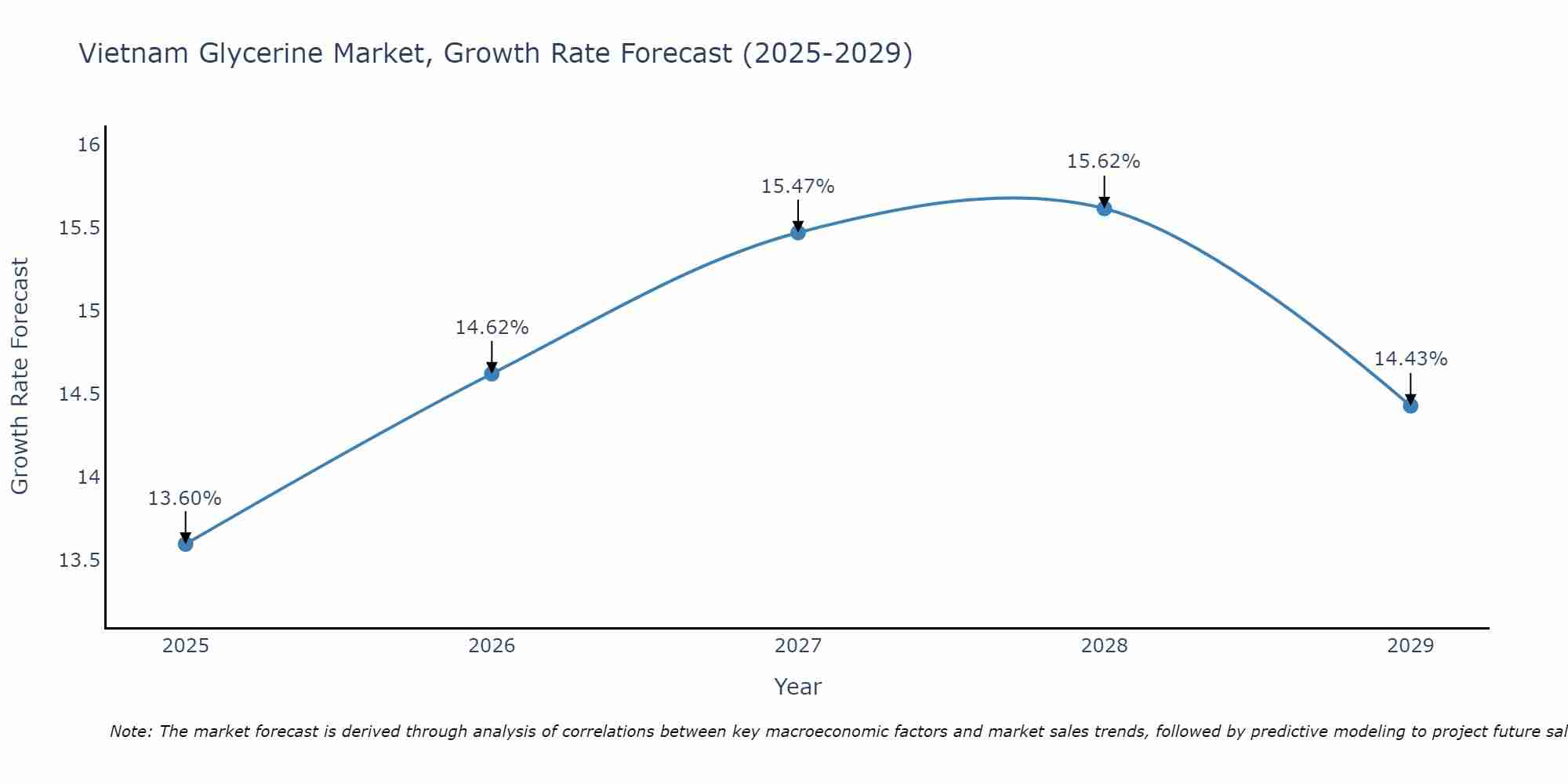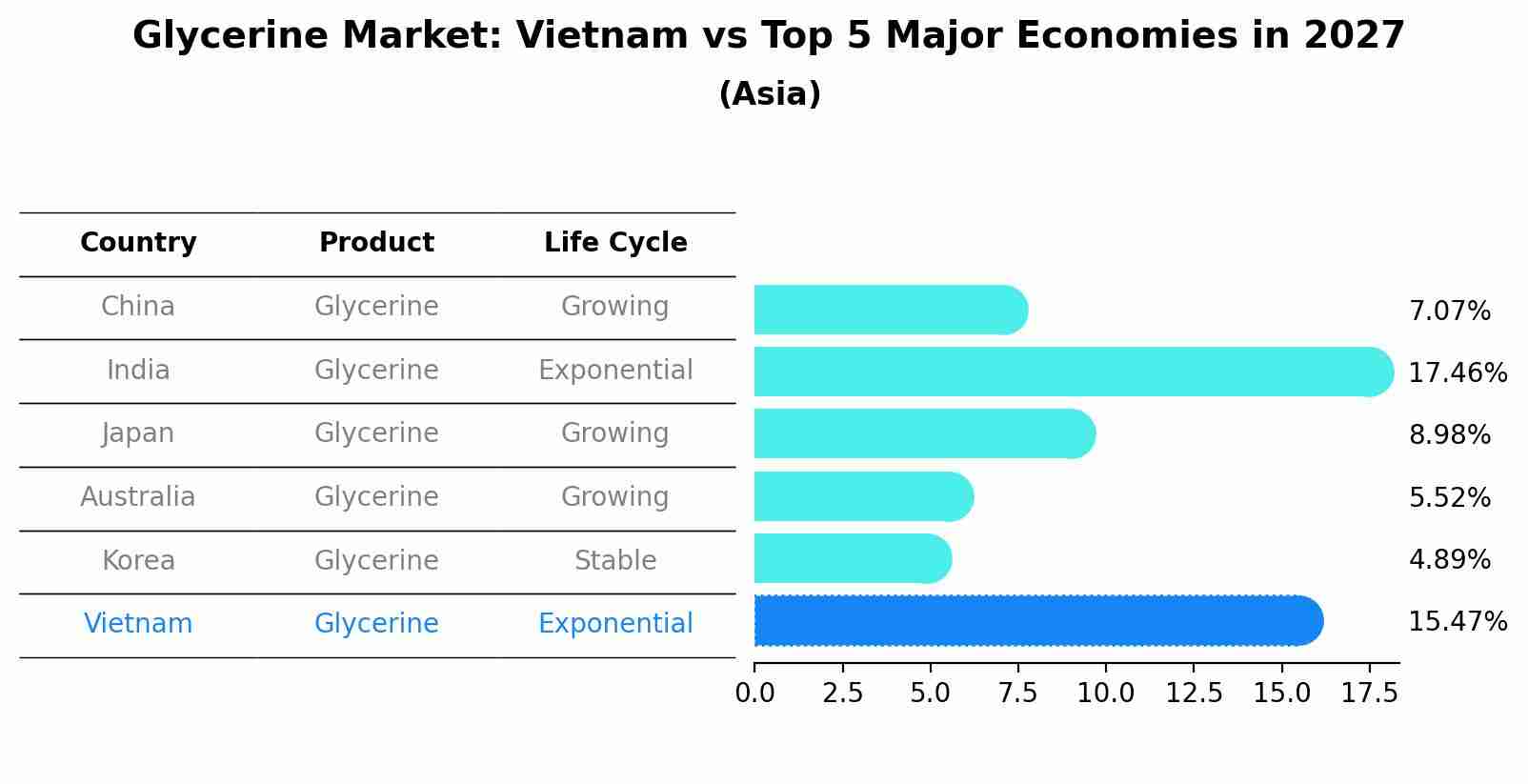Vietnam Glycerine Market (2025-2031) Outlook | Analysis, Forecast, Share, Growth, Companies, Value, Industry, Revenue, Size & Trends
Market Forecast By Grade (USP Grade, Technical Grade), By Application (Personal Care, Food & Beverages, Pharmaceuticals, Polyether Polyols, Chemical Intermediate, Tobacco, Others) And Competitive Landscape
| Product Code: ETC326730 | Publication Date: Aug 2022 | Updated Date: Apr 2025 | Product Type: Market Research Report | |
| Publisher: 6Wresearch | Author: Ravi Bhandari | No. of Pages: 75 | No. of Figures: 35 | No. of Tables: 20 |
Vietnam Glycerine Market Size Growth Rate
The Vietnam Glycerine Market is projected to witness mixed growth rate patterns during 2025 to 2029. Starting at 13.60% in 2025, the market peaks at 15.62% in 2028, and settles at 14.43% by 2029.

Glycerine Market: Vietnam vs Top 5 Major Economies in 2027 (Asia)
In the Asia region, the Glycerine market in Vietnam is projected to expand at a exponential growth rate of 15.47% by 2027. The largest economy is China, followed by India, Japan, Australia and South Korea.

Vietnam Glycerine Market Overiew
The glycerine market in Vietnam is a key component in various industries, including pharmaceuticals, cosmetics, and food manufacturing. Glycerine`s versatility as a humectant and solvent drives its demand, with market trends influenced by factors such as product innovation, sustainability goals, and regulatory compliance. Market participants face challenges related to sourcing raw materials, maintaining product quality, and staying abreast of technological developments in glycerine production.
Drivers of the Market
In Vietnam, the Glycerine market is propelled by diverse factors contributing to its widespread use in various industries. The cosmetic and personal care industry is a significant driver, with glycerine being a key ingredient in skincare and haircare products due to its moisturizing properties. Furthermore, the pharmaceutical sector utilizes glycerine in the formulation of drugs and medications. The food and beverage industry also contributes to market growth, where glycerine serves as a sweetener and humectant. The versatility of glycerine as an ingredient, coupled with its eco-friendly nature, fosters its adoption across different applications, driving the market forward.
Challenges of the Market
The Vietnam Glycerine Market grapples with challenges that influence its production and market dynamics. Volatility in the prices of raw materials, such as vegetable oils used in glycerine production, poses a significant challenge for manufacturers. Quality control and adherence to international standards are crucial in the glycerine industry, requiring continuous investments in technology and processes. Additionally, the market faces environmental scrutiny due to the by-products generated during glycerine production, necessitating sustainable practices and waste management strategies.
COVID 19 Impact on the Market
The Vietnam glycerine market felt the impact of the COVID-19 pandemic, with disruptions across various sectors. The pandemic-induced economic slowdown and restrictions on movement affected industrial activities, leading to a decline in demand for glycerine in certain applications. Additionally, the global supply chain disruptions impacted the availability of raw materials, affecting the production of glycerine. The market also faced challenges in terms of export and import dynamics, further contributing to the uncertainties. As the economy gradually recovers and industries resume operations, the glycerine market is anticipated to rebound, but ongoing global uncertainties may continue to influence market dynamics.
Key Players in the Market
In the thriving Vietnam Glycerine Market, key players such as Green Solutions Ltd., and Harmony Biochem are making significant contributions is renowned for its innovative glycerine production processes, ensuring high quality and sustainability. Green Solutions Ltd. has carved a niche with its eco-friendly glycerine solutions, while Harmony Biochem stands out for its commitment to meeting market demands with cutting-edge technology and customer-centric approaches.
Key Highlights of the Report:
- Vietnam Glycerine Market Outlook
- Market Size of Vietnam Glycerine Market, 2024
- Forecast of Vietnam Glycerine Market, 2031
- Historical Data and Forecast of Vietnam Glycerine Revenues & Volume for the Period 2021-2031
- Vietnam Glycerine Market Trend Evolution
- Vietnam Glycerine Market Drivers and Challenges
- Vietnam Glycerine Price Trends
- Vietnam Glycerine Porter's Five Forces
- Vietnam Glycerine Industry Life Cycle
- Historical Data and Forecast of Vietnam Glycerine Market Revenues & Volume By Grade for the Period 2021-2031
- Historical Data and Forecast of Vietnam Glycerine Market Revenues & Volume By USP Grade for the Period 2021-2031
- Historical Data and Forecast of Vietnam Glycerine Market Revenues & Volume By Technical Grade for the Period 2021-2031
- Historical Data and Forecast of Vietnam Glycerine Market Revenues & Volume By Application for the Period 2021-2031
- Historical Data and Forecast of Vietnam Glycerine Market Revenues & Volume By Personal Care for the Period 2021-2031
- Historical Data and Forecast of Vietnam Glycerine Market Revenues & Volume By Food & Beverages for the Period 2021-2031
- Historical Data and Forecast of Vietnam Glycerine Market Revenues & Volume By Pharmaceuticals for the Period 2021-2031
- Historical Data and Forecast of Vietnam Glycerine Market Revenues & Volume By Polyether Polyols for the Period 2021-2031
- Historical Data and Forecast of Vietnam Glycerine Market Revenues & Volume By Chemical Intermediate for the Period 2021-2031
- Historical Data and Forecast of Vietnam Glycerine Market Revenues & Volume By Tobacco for the Period 2021-2031
- Historical Data and Forecast of Vietnam Glycerine Market Revenues & Volume By Others for the Period 2021-2031
- Vietnam Glycerine Import Export Trade Statistics
- Market Opportunity Assessment By Grade
- Market Opportunity Assessment By Application
- Vietnam Glycerine Top Companies Market Share
- Vietnam Glycerine Competitive Benchmarking By Technical and Operational Parameters
- Vietnam Glycerine Company Profiles
- Vietnam Glycerine Key Strategic Recommendations
Frequently Asked Questions About the Market Study (FAQs):
- Single User License$ 1,995
- Department License$ 2,400
- Site License$ 3,120
- Global License$ 3,795
Search
Thought Leadership and Analyst Meet
Our Clients
Related Reports
- Germany Breakfast Food Market (2026-2032) | Industry, Share, Growth, Size, Companies, Value, Analysis, Revenue, Trends, Forecast & Outlook
- Australia Briquette Market (2025-2031) | Growth, Size, Revenue, Forecast, Analysis, Trends, Value, Share, Industry & Companies
- Vietnam System Integrator Market (2025-2031) | Size, Companies, Analysis, Industry, Value, Forecast, Growth, Trends, Revenue & Share
- ASEAN and Thailand Brain Health Supplements Market (2025-2031) | Strategy, Consumer Insights, Analysis, Investment Trends, Opportunities, Growth, Size, Share, Industry, Revenue, Segments, Value, Segmentation, Supply, Forecast, Restraints, Outlook, Competition, Drivers, Trends, Demand, Pricing Analysis, Competitive, Strategic Insights, Companies, Challenges
- ASEAN Bearings Market (2025-2031) | Strategy, Consumer Insights, Analysis, Investment Trends, Opportunities, Growth, Size, Share, Industry, Revenue, Segments, Value, Segmentation, Supply, Forecast, Restraints, Outlook, Competition, Drivers, Trends, Demand, Pricing Analysis, Competitive, Strategic Insights, Companies, Challenges
- Europe Flooring Market (2025-2031) | Outlook, Share, Industry, Trends, Forecast, Companies, Revenue, Size, Analysis, Growth & Value
- Saudi Arabia Manlift Market (2025-2031) | Outlook, Size, Growth, Trends, Companies, Industry, Revenue, Value, Share, Forecast & Analysis
- Uganda Excavator, Crane, and Wheel Loaders Market (2025-2031) | Strategy, Consumer Insights, Analysis, Investment Trends, Opportunities, Growth, Size, Share, Industry, Revenue, Segments, Value, Segmentation, Supply, Forecast, Restraints, Outlook, Competition, Drivers, Trends, Demand, Pricing Analysis, Competitive, Strategic Insights, Companies, Challenges
- Rwanda Excavator, Crane, and Wheel Loaders Market (2025-2031) | Strategy, Consumer Insights, Analysis, Investment Trends, Opportunities, Growth, Size, Share, Industry, Revenue, Segments, Value, Segmentation, Supply, Forecast, Restraints, Outlook, Competition, Drivers, Trends, Demand, Pricing Analysis, Competitive, Strategic Insights, Companies, Challenges
- Kenya Excavator, Crane, and Wheel Loaders Market (2025-2031) | Strategy, Consumer Insights, Analysis, Investment Trends, Opportunities, Growth, Size, Share, Industry, Revenue, Segments, Value, Segmentation, Supply, Forecast, Restraints, Outlook, Competition, Drivers, Trends, Demand, Pricing Analysis, Competitive, Strategic Insights, Companies, Challenges
Industry Events and Analyst Meet
Whitepaper
- Middle East & Africa Commercial Security Market Click here to view more.
- Middle East & Africa Fire Safety Systems & Equipment Market Click here to view more.
- GCC Drone Market Click here to view more.
- Middle East Lighting Fixture Market Click here to view more.
- GCC Physical & Perimeter Security Market Click here to view more.
6WResearch In News
- Doha a strategic location for EV manufacturing hub: IPA Qatar
- Demand for luxury TVs surging in the GCC, says Samsung
- Empowering Growth: The Thriving Journey of Bangladesh’s Cable Industry
- Demand for luxury TVs surging in the GCC, says Samsung
- Video call with a traditional healer? Once unthinkable, it’s now common in South Africa
- Intelligent Buildings To Smooth GCC’s Path To Net Zero


















